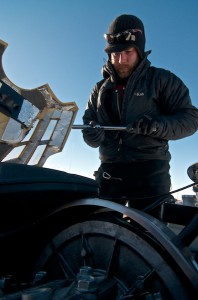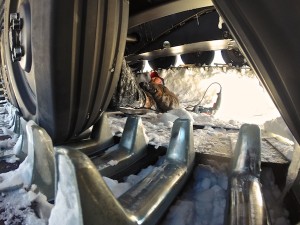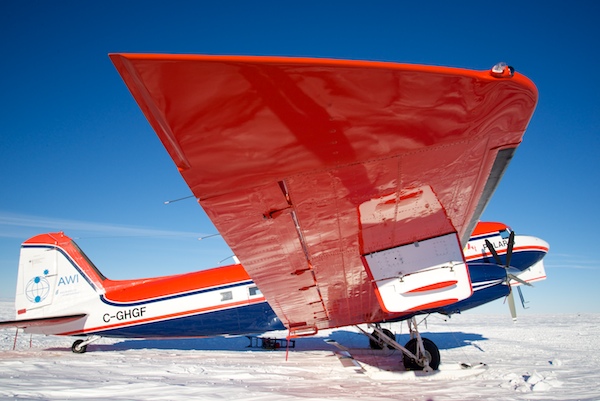We apologise for the delay in uploading more instalments in the iSTAR blog. While those of us in Cambridge were on holiday, the traverse has continued doing its work on Pine Island Glacier. The latest update comes from mechanic Mark Baird:

Deep Field Mechanic Mark Baird Services a field ski-doo. Photo: Alex Taylor.
Life as a mechanic on the iSTAR traverse is definitely not your average job! In reality the job is much more varied than any normal mechanic or operator would expect. I work as part of a three-man team consisting of James Wake (Traverse Leader), Tim Gee (Mechanic and PistenBully Guru) and myself. We are the logistics and safety side of the traverse, essentially our job is to get the scientists and equipment to and from sites safely and to help out as needed when on site. When it comes to safety James is always on the ball, he seems to have a sixth sense about impending bad weather and is always on hand with a radio and a line of black flags to guide everyone safely to the caboose to make use of our bottomless teapots.
Tim and I, on the other hand, spend our time fixing and fettling a mixture of things around camp as well as numerous gismos and gadgets related to the science. Our main role, however, is in looking after the two PistenBully snow groomers, 4 Ski-Doos, various generators and of course the caboose. One of our first major jobs was to service the two PistenBully’s (PB’s). Back at home in a nice warm workshop this would be a pleasant and relatively simple task, as the PB’s are a pleasure to work on. However, when this job needs to be done to a machine that has just been awoken from a 9-month hibernation in the Antarctic wilderness and is encrusted in a thick layer of ice it is no mean feat. The first thing we must attend to prior to any work commencing is de-icing the machines. This in itself is a large and difficult job when done in temperatures below -20 and with no indoor space to work in. As with all things in Antarctica a low-tech solution is best. A space heater with a pipe, a screwdriver and a soft hammer, plus a large dose of patience and perseverance, is the only way. The only shelter available is a small berm (a pile of snow) in front of the machine and an old parachute used to cover part of the PB as we work. After a few days work we had completed the service on the first PB and were preparing to begin the whole process again on the second machine.

Deep Field Mechanic Tim Gee assesses a repair to the PistenBully’s undercarraige. Photo: Alex Taylor.
The job of a mechanic on iSTAR is not however limited to fixing and driving PB’s. A large proportion of our time is spent working with the scientists assisting with various tasks, especially the more labour intensive ones (most of the work involves a lot of digging). I’ve also assisted the ice core drillers with collecting cores, done some hot water drilling for the seismic work and helped dig out the GPS stations that have been in place since last year. For safety reasons we never work alone when out of camp and unoccupied traverse members are regularly hijacked to assist with mini expeditions to take various GPS measurements from strain stakes (long poles sunk into the ice used to accurately measure glacial flow) located a few km away from camp.
The busiest days for a mech are move days and aircraft visits. Our first job on any of these days is to get the PB’s up and running which takes around an hour due to the cold. Once everything is warmed up and most importantly we have had our tea and porridge, we can begin the task of breaking down camp and hitching up the wagons. It’s amazing how quickly everyone has fallen into a rhythm. Watching camp dissolve in front of you to become two neat trains ready to head off once again into the wild white wilderness of Antarctica is truly impressive. One of the other main tasks we are involved with is incoming and outgoing aircraft. As we are the baggage handlers, air traffic control, ski-way manufacturers, refuelling team and ground crew it keeps you pretty busy. Recently we had Polar 6 visiting camp for a few days. Polar 6 is a Basler BT-67 (a modernised Douglas DC-3 aircraft – originally developed before World War 2), which was being used to survey the path of the iSTAR traverse.
It was during the refuelling of this aircraft that I had one of my most poignant Antarctic moments so far. I was sitting on the fuel sledge behind the PB and watching the Basler taxi in beside us having just landed on a ski-way I had been working on that morning, the sun was shining it was around -20°C and I couldn’t help but look out in awe and amazement, thinking that this is where I work!

“Polar 6”, The AWI Basler aircraft parked overnight at iSTAR Site 13, Pine Island Glacier. A white aerial radar sensor can be seen suspended under the wing. Photo: Alex Taylor.
